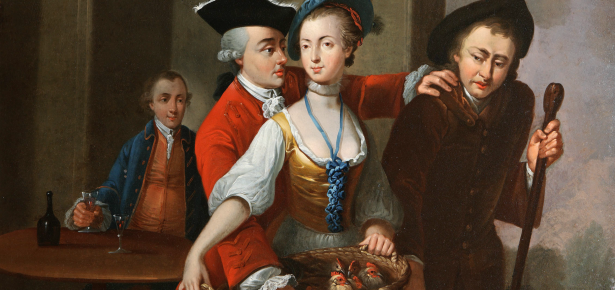
I like to think that much of what this book offers – Irish Literature in Transition, 1700-1780 – is suggested in the image which illustrates its dust-jacket: an engraved copy of Philip Mercier’s painting of the Irish actor Robert Wilks in the part of Captain Plume in Farquhar’s The Recruiting Officer (1706). Both actor and playwright are Irish, but the production is almost certainly one staged in London: here we already have that crossing of culture which is such a feature of the period. In that regard, the painting hints at the way in which many Irish authors and performers sought fortune or fame on the London stage (Farquhar, Richard Brinsley Sheridan, Goldsmith, most famously) or through the publication of London-printed books (Swift, Burke, Goldsmith again). The linking of Dublin and London in the period is commonly known and acknowledged – but it has also ossified into something of a truism in the phrase ‘Anglo-Irish’, a neat term in that its hyphen stands in for the kind of crossing noted above and appears to do justice to the complexity of being ‘English’ and ‘Irish’. Recent studies of eighteenth-century Ireland, however, have moved far beyond the idea of a binary opposition. As this volume of nineteen chapters amply testifies, there are many more than two sides to the stories told both in and of the eighteenth century.
The ‘many-angled’ view of the volume as a whole can also be glimpsed in Mercier’s image. Beyond the figure of the Recruiting Officer Plume, this scene (which specifically depicts Act III scene i of Farquhar’s play) shows us the country maid Rose with her basket of chickens for sale; Rose’s brother, Bullock, being roughly grasped by Plume; and, lurking in the background, Sergeant Kite, who has been tipped a wink by Plume on Bullock as a potential ‘recruit’ into the British army while Plume gets on with dallying with Rose. The painting in very obvious ways reaches beyond the conventional ‘Georgian’ image of gentlemen in wigs, which could so easily provide a visual correlative to ideas of ‘Anglo-Irishness’. Here, the painting is most notable, perhaps, for its representation of plebeian street life and for the way in which its ‘country wench’ is positioned as the painting’s central focal point: she alone looks at us. In the most obvious of ways, then, the image is an appropriate one for a volume which includes, among many other diverse topics, studies of ‘rogue’ and popular literature, gender and sexuality, women writers, the intersection of Gaelic and Anglophone cultures, and criminality, deception and theatricality of various kinds and shades. The painting immediately conveys an ‘impolite’ century which is at odds with Ascendancy views of its own culture – the beautiful objects of elite social life which remain in gorgeous artefacts such as silverware and country estates, for example. Literature, this volume argues, has almost invariably been at odds with ‘Ascendancy’ culture defined by its polish and refinement, by its elegant simplicity and neat binaries. Instead, printed, manuscript and oral cultures of the period are, more typically, noisy and conflicted, experimental and innovative, spirited and racy.
In its considerations of many recently rediscovered authors, texts and genres, and in the multiplicity of its contextual frames and conceptual inflections, this volume offers a view of eighteenth-century Irish writing which is far from conventional. I think many readers will be surprised, and pleasantly surprised, by what they encounter within the pages of this volume, not least because the image of the bewigged Anglo-Irish gentleman of eighteenth-century Ireland continues to dominate popular perceptions of the period and is so strongly displaced by the many views and studies which the chapters collectively offer.

Latest Comments
Have your say!